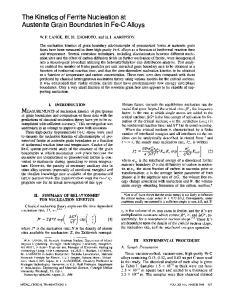Pinning of Austenite Grain Boundaries by
- PDF / 1,739,236 Bytes
- 9 Pages / 597 x 774 pts Page_size
- 114 Downloads / 381 Views
I.
INTRODUCTION
AT high temperatures, the microstructure of polycrystalline materials evolves to a coarser scale as a result of a driving force that causes the grain boundaries to move. This evolution can proceed uniformly, resulting in normal grain growth, or nonuniformly, resulting in abnormal grain growth. The growth mode is greatly affected by the presence of second-phase particles. The second-phase particles are themselves unstable at high temperatures. In many cases, they will either coarsen due to a difference in the chemical potential of the solute atoms resulting from a difference in particle size, or they will dissolve because of an increasing solubility of the solute atoms in the matrix at elevated temperatures. The interaction of grain boundaries with second-phase particles has been a subject of great interest since Zener proposed a simple model of that interaction in an article written by Smith in 1948. m In this model, Zener balanced the driving force for motion acting on a rigid grain boundary with the counterforce exerted by spherical particles on the boundary. At equilibrium, the following equation was obtained: 23,
3~b3, -
- -
2r
[11
Here, 3, is the grain-boundary free energy,/~ is the average radius of spherical grains, ~b is the volume fraction of the second-phase particles, and r is the average particle radius. In the years since, a number of efforts have been made to improve on Zener's model by relaxing some of the assumptions originally made to simplify the problem. Gladman, 12j taking into account the distorted shape of (3MER N. DOGAN, Research Associate, and G.M. MICHAL, LTV Steel Associate Professor of Metallurgy, are with the Department of Materials Science and Engineering, Case Western Reserve University, Cleveland, OH 44106. H.-W. KWON, Associate Professor, is with the Department of Metallurgical Engineering, Yeungnam University, Kyongbuk 632, Republic of Korea. Manuscript submitted August 6, 1991. METALLURGICAL TRANSACTIONS A
a planar grain boundary pinned by a second-phase particle and the inhomogeneity in grain-size distribution, proposed a model described by the following equation: -
(2]
rrr
4/~
3Rmax
is the radius of the largest grain in the distribution of grain sizes. Hellman and Hillert 131calculated the shape of the disturbed boundary as a catenoid, determining that the net curvature of the boundary at any point near the particle is zero during pinning. Unlike Gladman, they accounted for the curvature (1/p) of the grain boundary away from the particle that provides the driving force for migration. They also found that during pinning, the undisturbed spherical part of the grain boundary moves farther away from the particle as the p/r ratio increases. Therefore, they suggested that a correction factor, H e r e , Rma x
fl = 0.125 In ( ~ - ~ )
[3]
should be multiplied with the right-hand side of Eq. [ 1]. They further related the driving force for grain boundary motion to the grain radius using the equation m 1
3,g(1 + ~)=
Tk(~Tr - 1 )
[4]
where g and k are cons
Data Loading...











